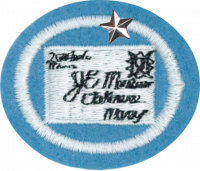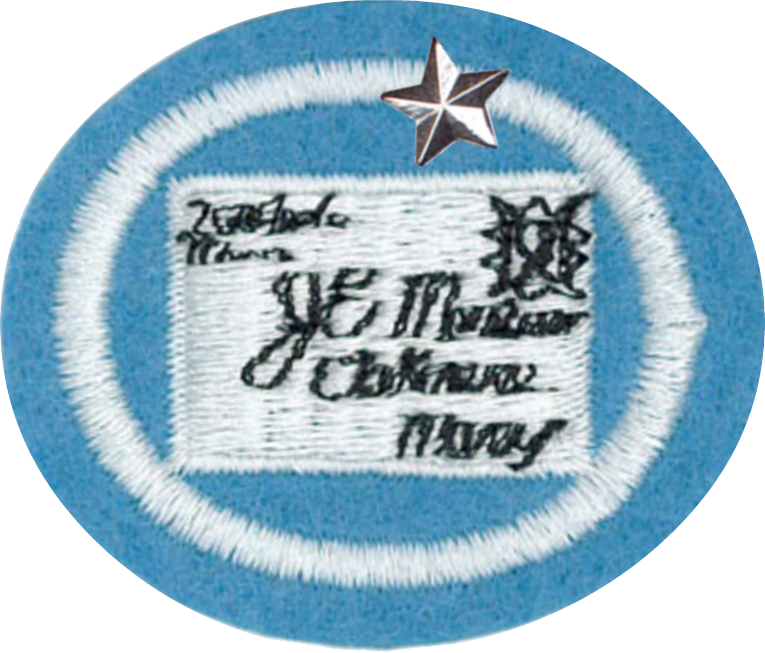Difference between revisions of "AY Honors/Stamps - Advanced/Answer Key/es"
From Pathfinder Wiki
< AY Honors | Stamps - AdvancedAY Honors/Stamps - Advanced/Answer Key/es
(Created page with "Especialidades JA/Filatelia - Avanzado/Respuestas") |
|||
| (4 intermediate revisions by 2 users not shown) | |||
| Line 2: | Line 2: | ||
<section begin="Body" /> | <section begin="Body" /> | ||
{{ansreq|page={{#titleparts:{{PAGENAME}}|2|1}}|num=1}} | {{ansreq|page={{#titleparts:{{PAGENAME}}|2|1}}|num=1}} | ||
| − | <noinclude> | + | <noinclude></noinclude> |
| − | </noinclude> | + | <!-- 1. Tener la especialidad de Filatelia. --> |
| − | <!-- 1. | + | {{honor_prerequisite|displayname=Filatelia|honor=Stamps}} |
| − | {{honor_prerequisite| | ||
| − | |||
| − | + | <noinclude></noinclude> | |
| − | <noinclude | ||
| − | |||
{{CloseReq}} <!-- 1 --> | {{CloseReq}} <!-- 1 --> | ||
{{ansreq|page={{#titleparts:{{PAGENAME}}|2|1}}|num=2}} | {{ansreq|page={{#titleparts:{{PAGENAME}}|2|1}}|num=2}} | ||
| − | <noinclude> | + | <noinclude></noinclude> |
| − | </noinclude> | + | <!-- 2. Conocer el significado de los siguientes términos: --> |
| − | <!-- 2. | + | <noinclude></noinclude> |
| − | <noinclude | ||
| − | |||
{{ansreq|page={{#titleparts:{{PAGENAME}}|2|1}}|num=2a}} | {{ansreq|page={{#titleparts:{{PAGENAME}}|2|1}}|num=2a}} | ||
| − | <noinclude> | + | <noinclude></noinclude> |
| − | </noinclude> | + | <noinclude></noinclude> |
| − | |||
| − | <noinclude | ||
| − | |||
{{CloseReq}} <!-- 2a --> | {{CloseReq}} <!-- 2a --> | ||
{{ansreq|page={{#titleparts:{{PAGENAME}}|2|1}}|num=2b}} | {{ansreq|page={{#titleparts:{{PAGENAME}}|2|1}}|num=2b}} | ||
| − | <noinclude> | + | <noinclude></noinclude> |
| − | </noinclude> | + | <noinclude></noinclude> |
| − | |||
| − | <noinclude | ||
| − | |||
{{CloseReq}} <!-- 2b --> | {{CloseReq}} <!-- 2b --> | ||
{{ansreq|page={{#titleparts:{{PAGENAME}}|2|1}}|num=2c}} | {{ansreq|page={{#titleparts:{{PAGENAME}}|2|1}}|num=2c}} | ||
| − | <noinclude> | + | <noinclude></noinclude> |
| − | </noinclude> | + | <noinclude></noinclude> |
| − | |||
| − | <noinclude | ||
| − | |||
{{CloseReq}} <!-- 2c --> | {{CloseReq}} <!-- 2c --> | ||
{{ansreq|page={{#titleparts:{{PAGENAME}}|2|1}}|num=2d}} | {{ansreq|page={{#titleparts:{{PAGENAME}}|2|1}}|num=2d}} | ||
| − | <noinclude> | + | <noinclude></noinclude> |
| − | </noinclude | + | <noinclude></noinclude> |
| − | |||
| − | |||
| − | |||
| − | <noinclude | ||
| − | |||
{{CloseReq}} <!-- 2d --> | {{CloseReq}} <!-- 2d --> | ||
{{ansreq|page={{#titleparts:{{PAGENAME}}|2|1}}|num=2e}} | {{ansreq|page={{#titleparts:{{PAGENAME}}|2|1}}|num=2e}} | ||
| − | <noinclude> | + | <noinclude></noinclude> |
| − | </noinclude> | + | <noinclude></noinclude> |
| − | |||
| − | <noinclude | ||
| − | |||
{{CloseReq}} <!-- 2e --> | {{CloseReq}} <!-- 2e --> | ||
{{ansreq|page={{#titleparts:{{PAGENAME}}|2|1}}|num=2f}} | {{ansreq|page={{#titleparts:{{PAGENAME}}|2|1}}|num=2f}} | ||
| − | <noinclude> | + | <noinclude></noinclude> |
| − | </noinclude> | + | <noinclude></noinclude> |
| − | |||
| − | <noinclude | ||
| − | |||
{{CloseReq}} <!-- 2f --> | {{CloseReq}} <!-- 2f --> | ||
{{ansreq|page={{#titleparts:{{PAGENAME}}|2|1}}|num=2g}} | {{ansreq|page={{#titleparts:{{PAGENAME}}|2|1}}|num=2g}} | ||
| − | <noinclude> | + | <noinclude></noinclude> |
| − | </noinclude | ||
| − | |||
| − | |||
| − | + | <noinclude></noinclude> | |
| − | |||
| − | <noinclude | ||
| − | |||
{{CloseReq}} <!-- 2g --> | {{CloseReq}} <!-- 2g --> | ||
{{ansreq|page={{#titleparts:{{PAGENAME}}|2|1}}|num=2h}} <!--T:3--> | {{ansreq|page={{#titleparts:{{PAGENAME}}|2|1}}|num=2h}} <!--T:3--> | ||
| − | <noinclude> | + | <noinclude></noinclude> |
| − | </noinclude> | + | <noinclude></noinclude> |
| − | |||
| − | <noinclude | ||
| − | |||
{{CloseReq}} <!-- 2h --> | {{CloseReq}} <!-- 2h --> | ||
{{ansreq|page={{#titleparts:{{PAGENAME}}|2|1}}|num=2i}} | {{ansreq|page={{#titleparts:{{PAGENAME}}|2|1}}|num=2i}} | ||
| − | <noinclude> | + | <noinclude></noinclude> |
| − | </noinclude> | + | <noinclude></noinclude> |
| − | |||
| − | <noinclude | ||
| − | |||
{{CloseReq}} <!-- 2i --> | {{CloseReq}} <!-- 2i --> | ||
{{ansreq|page={{#titleparts:{{PAGENAME}}|2|1}}|num=2j}} | {{ansreq|page={{#titleparts:{{PAGENAME}}|2|1}}|num=2j}} | ||
| − | <noinclude> | + | <noinclude></noinclude> |
| − | </noinclude> | + | <noinclude></noinclude> |
| − | |||
| − | <noinclude | ||
| − | |||
{{CloseReq}} <!-- 2j --> | {{CloseReq}} <!-- 2j --> | ||
{{CloseReq}} <!-- 2 --> | {{CloseReq}} <!-- 2 --> | ||
{{ansreq|page={{#titleparts:{{PAGENAME}}|2|1}}|num=3}} | {{ansreq|page={{#titleparts:{{PAGENAME}}|2|1}}|num=3}} | ||
| − | <noinclude> | + | <noinclude></noinclude> |
| − | </noinclude> | + | <!-- 3. Hacer una exposición de al menos 16 páginas adecuado para un club de sellos, la Feria de Conquistadores, o Feria Juvenil de Filatelia. La exposición debe ser artísticamente organizada, perfectamente etiquetada y montada, mostrando una cuidadosa reflexión e investigación. Caches y cubiertas deben utilizarse también. --> |
| − | <!-- 3. | + | <noinclude></noinclude> |
| − | |||
| − | <noinclude | ||
| − | |||
{{CloseReq}} <!-- 3 --> | {{CloseReq}} <!-- 3 --> | ||
{{ansreq|page={{#titleparts:{{PAGENAME}}|2|1}}|num=4}} | {{ansreq|page={{#titleparts:{{PAGENAME}}|2|1}}|num=4}} | ||
| − | <noinclude> | + | <noinclude></noinclude> |
| − | </noinclude> | + | <!-- 4. Hacer una colección de 750 sellos adicionales con un mínimo de 50 sellos de cinco países extranjeros. --> |
| − | <!-- 4. | + | <noinclude></noinclude> |
| − | |||
| − | <noinclude | ||
| − | |||
{{CloseReq}} <!-- 4 --> | {{CloseReq}} <!-- 4 --> | ||
{{ansreq|page={{#titleparts:{{PAGENAME}}|2|1}}|num=5}} | {{ansreq|page={{#titleparts:{{PAGENAME}}|2|1}}|num=5}} | ||
| − | <noinclude> | + | <noinclude></noinclude> |
| − | </noinclude> | + | <!-- 5. Nombrar dos catálogos para la identificación de los sellos. --> |
| − | <!-- 5. | ||
| − | |||
| − | |||
| − | + | {{clear}} | |
| − | |||
| − | |||
| − | + | <noinclude></noinclude> | |
| − | |||
| − | |||
| − | |||
| − | |||
| − | |||
| − | <noinclude | ||
| − | |||
{{CloseReq}} <!-- 5 --> | {{CloseReq}} <!-- 5 --> | ||
{{ansreq|page={{#titleparts:{{PAGENAME}}|2|1}}|num=6}} | {{ansreq|page={{#titleparts:{{PAGENAME}}|2|1}}|num=6}} | ||
| − | <noinclude> | + | <noinclude></noinclude> |
| − | </noinclude> | + | <!-- 6. Usando un catálogo de sellos, identificar y montar de acuerdo con el número de catálogo y el país. --> |
| − | <!-- 6. | + | <noinclude></noinclude> |
| − | |||
| − | <noinclude | ||
| − | |||
{{CloseReq}} <!-- 6 --> | {{CloseReq}} <!-- 6 --> | ||
{{ansreq|page={{#titleparts:{{PAGENAME}}|2|1}}|num=7}} | {{ansreq|page={{#titleparts:{{PAGENAME}}|2|1}}|num=7}} | ||
| − | <noinclude> | + | <noinclude></noinclude> |
| − | </noinclude> | + | <!-- 7. Montar sus sellos con bisagras de papel engomado o monturas de plástico. Monturas de plástico se prefiere para la acuñación de sellos. --> |
| − | <!-- 7. | + | <noinclude></noinclude> |
| − | |||
| − | |||
| − | |||
| − | <noinclude | ||
| − | |||
{{CloseReq}} <!-- 7 --> | {{CloseReq}} <!-- 7 --> | ||
| + | |||
| + | [[Category:AY Honors/Stamps]] | ||
| + | |||
{{CloseHonorPage}} | {{CloseHonorPage}} | ||
Latest revision as of 20:14, 5 October 2021
Filatelia - Avanzado
Nivel de destreza
3
Año
1933
Version
21.12.2025
Autoridad de aprobación
Asociación General
1
Tener la especialidad de Filatelia.
Para consejos e instrucciones, véase Filatelia.
2
Conocer el significado de los siguientes términos:
2a
Cancelación
2b
Sellos con letras perforadas
2c
Bloques
2d
Bloques planchados
2e
Bloques planchados
2f
Primer día de emisión
2g
Caches
2h
Hojas conmemorativas
2i
Marcas de agua
2j
Tenazas
3
Hacer una exposición de al menos 16 páginas adecuado para un club de sellos, la Feria de Conquistadores, o Feria Juvenil de Filatelia. La exposición debe ser artísticamente organizada, perfectamente etiquetada y montada, mostrando una cuidadosa reflexión e investigación. Caches y cubiertas deben utilizarse también.
4
Hacer una colección de 750 sellos adicionales con un mínimo de 50 sellos de cinco países extranjeros.
5
Nombrar dos catálogos para la identificación de los sellos.
6
Usando un catálogo de sellos, identificar y montar de acuerdo con el número de catálogo y el país.
7
Montar sus sellos con bisagras de papel engomado o monturas de plástico. Monturas de plástico se prefiere para la acuñación de sellos.


